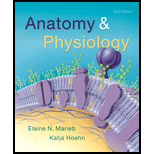
When the semilunar valves are open, which of the following are occurring? (a) 2, 3, 5, 6, (b) 1, 2, 3, 7, (c) 1, 3, 5, 6, (d) 2, 4, 5, 7.
_____(1) coronary arteries fill
_____(2) AV valves are closed
_____(3) ventricles are in systole
_____(4) ventricles are in diastole
_____(5) blood enters aorta
_____(6) blood enters pulmonary arteries
_____(7) atria contract
To determine:
The correct occurrence of sequences if semilunar valves are open
(a) 2, 3, 5, 6, (b) 1, 2, 3, 7, (c) 1, 3, 5, 6, (d) 2, 4, 5, 7
____ (1) coronary arteries fill
____ (2) AV valves are closed
____ (3) ventricles are in systole
____ (4) ventricles are in diastole
____ (5) blood enters aorta
____ (6) blood enters pulmonary arteries
____ (7) atria contract
Answer to Problem 1MC
Solution:
(a) 2, 3, 5, 6: The events that occur when the semilunar valves are open are listed as follows:
1. The closing of atrioventricular valves.
2. The ventricles are in the systolic stage.
3. The blood enters the aorta.
4. The blood enters the pulmonary arteries.
Explanation of Solution
The semilunar valve is situated between the left ventricle and aorta of the heart. The opening of the semilunar valves marks the systolic stage. The atrioventricular valves at this stage are closed in order to prevent the backflow of the blood. The blood is pumped to the aorta and the pulmonary artery to distribute it to the different parts of the body.
Want to see more full solutions like this?
Chapter 17 Solutions
Anatomy & Physiology (6th Edition)
- Amino Acid Coclow TABle 3' Gly Phe Leu (G) (F) (L) 3- Val (V) Arg (R) Ser (S) Ala (A) Lys (K) CAG G Glu Asp (E) (D) Ser (S) CCCAGUCAGUCAGUCAG 0204 C U A G C Asn (N) G 4 A AGU C GU (5) AC C UGA A G5 C CUGACUGACUGACUGAC Thr (T) Met (M) lle £€ (1) U 4 G Tyr Σε (Y) U Cys (C) C A G Trp (W) 3' U C A Leu בוט His Pro (P) ££ (H) Gin (Q) Arg 흐름 (R) (L) Start Stop 8. Transcription and Translation Practice: (Video 10-1 and 10-2) A. Below is the sense strand of a DNA gene. Using the sense strand, create the antisense DNA strand and label the 5' and 3' ends. B. Use the antisense strand that you create in part A as a template to create the mRNA transcript of the gene and label the 5' and 3' ends. C. Translate the mRNA you produced in part B into the polypeptide sequence making sure to follow all the rules of translation. 5'-AGCATGACTAATAGTTGTTGAGCTGTC-3' (sense strand) 4arrow_forwardWhat is the structure and function of Eukaryotic cells, including their organelles? How are Eukaryotic cells different than Prokaryotic cells, in terms of evolution which form of the cell might have came first? How do Eukaryotic cells become malignant (cancerous)?arrow_forwardWhat are the roles of DNA and proteins inside of the cell? What are the building blocks or molecular components of the DNA and proteins? How are proteins produced within the cell? What connection is there between DNA, proteins, and the cell cycle? What is the relationship between DNA, proteins, and Cancer?arrow_forward
- please fill in the empty sports, thank you!arrow_forwardIn one paragraph show how atoms and they're structure are related to the structure of dna and proteins. Talk about what atoms are. what they're made of, why chemical bonding is important to DNA?arrow_forwardWhat are the structure and properties of atoms and chemical bonds (especially how they relate to DNA and proteins).arrow_forward
- The Sentinel Cell: Nature’s Answer to Cancer?arrow_forwardMolecular Biology Question You are working to characterize a novel protein in mice. Analysis shows that high levels of the primary transcript that codes for this protein are found in tissue from the brain, muscle, liver, and pancreas. However, an antibody that recognizes the C-terminal portion of the protein indicates that the protein is present in brain, muscle, and liver, but not in the pancreas. What is the most likely explanation for this result?arrow_forwardMolecular Biology Explain/discuss how “slow stop” and “quick/fast stop” mutants wereused to identify different protein involved in DNA replication in E. coli.arrow_forward
 Human Physiology: From Cells to Systems (MindTap ...BiologyISBN:9781285866932Author:Lauralee SherwoodPublisher:Cengage Learning
Human Physiology: From Cells to Systems (MindTap ...BiologyISBN:9781285866932Author:Lauralee SherwoodPublisher:Cengage Learning Fundamentals of Sectional Anatomy: An Imaging App...BiologyISBN:9781133960867Author:Denise L. LazoPublisher:Cengage Learning
Fundamentals of Sectional Anatomy: An Imaging App...BiologyISBN:9781133960867Author:Denise L. LazoPublisher:Cengage Learning Human Biology (MindTap Course List)BiologyISBN:9781305112100Author:Cecie Starr, Beverly McMillanPublisher:Cengage Learning
Human Biology (MindTap Course List)BiologyISBN:9781305112100Author:Cecie Starr, Beverly McMillanPublisher:Cengage Learning





